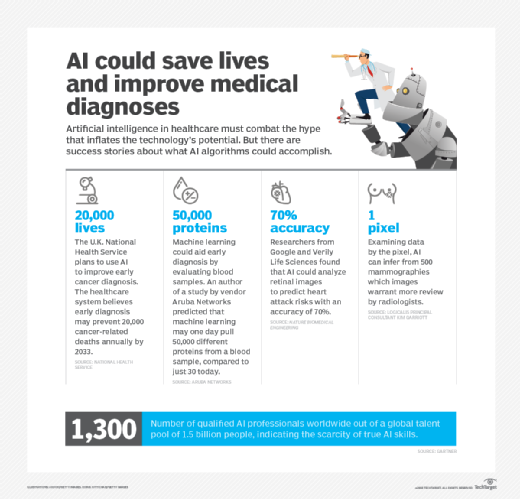
Wilm Ihlenfeld - Fotolia
Use of AI-assisted surgery remains limited despite its benefits
While AI adoption to assist with surgeries remains limited, the technology holds great potential to increase quality of care and decrease patient risk.
AI-enabled systems are increasingly showing their ability to help humans work in more efficient and detailed ways. Many tasks once considered to be able to be performed only by humans are now seeing the benefits of AI assistance, an application of AI known as augmented intelligence.
One augmented intelligence application that has seen great promise is AI-assisted surgery. As the name suggests, these systems aid a surgeon by acting as an extra pair of hands or eyes.
Over the past few decades, healthcare facilities have increasingly adopted AI and robotic technology, including the use of surgical robots, and AI-enabled medical imaging and assistive diagnosis. Here are some of the benefits of using AI in a surgical setting.
Identify, simplify and augment surgery
AI has been very useful in identifying anomalies in medical imaging. For example, when it comes to cancer-positive lymph nodes, AI has been able to help increase detection rates, reducing the number of missed diagnoses and helping to save lives.
AI-assisted identification of the initial problem and resulting surgical site location is not only simplifying procedures but, in some cases, reducing or eliminating the need for surgery in the first place.
Surgical augmented intelligence systems are also being used to create 3D images of the body. This provides doctors with a much more accurate reference when preparing for and conducting surgery.
Reduce scaring and incisions
Several AI-powered tools -- such as microscopes that can improve a doctor's ability to see what they are working on -- have been employed to aid surgeons and reduce risks associated with incisions.
Providing extreme precision, skill, dexterity and control to surgeons, robotic-assisted surgeries enhance operating room capabilities, resulting in fewer mistakes and reduced complications as a result of more pinpointed incisions and tool placement. Additionally, closing and suturing incision sites with robotic AI tools can greatly augment a surgeon's ability.
AI-assisted surgery also results in smaller scars, less damage to body parts, reduced inflammation and quicker recovery time for patients. This means individuals can spend less time recovering in the hospital and at home.

Limit surgical fatigue
Especially with longer and more complicated procedures, surgical fatigue can be a big risk for all involved parties. By adding AI-powered robotics to the equation, as well as the use of better imaging aids and other AI-enabled equipment, a surgeon can reduce their workload. This gives them the ability to remain fresh and, in theory, make fewer medical mistakes.
During surgery, other parts of the body that are not being operated on can experience stress. AI-assisted tools help surgeons to reduce the chances that other parts of the body are damaged due to an accidental nick, cross contamination or other issue during an operation.
While the promise of AI-assisted surgery is significant, numerous medical agencies heavily regulate the technology because of the sensitivity and risk involved in surgical procedures. Due to these regulations, AI tools are still in a nascent state.
To this point, there has not been any approved autonomous AI surgical systems, and the limited systems that have been approved all require a human to be kept in the loop. In the coming years, it is likely AI will continue to enhance medical care and, quite possibly, we'll see more use of the technology not just working alongside highly trained professionals, but potentially operating autonomously as well.







